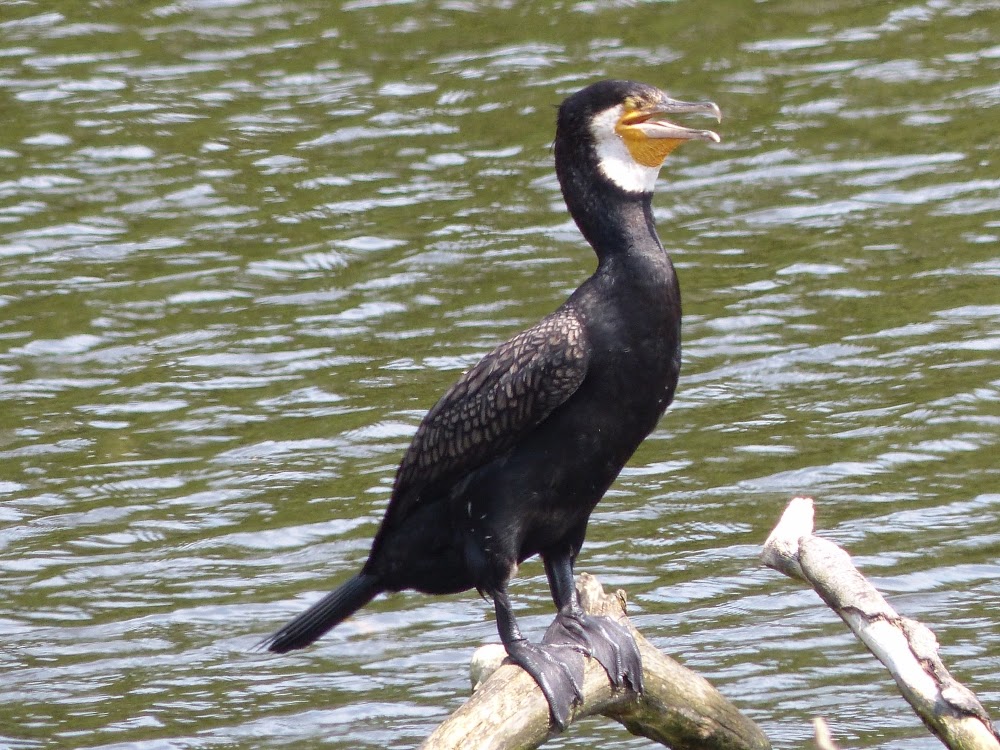The hot weather was affecting a Cormorant perched in the fallen horse chestnut tree on the Long Water. It was panting and vibrating its throat to cool down, causing its neck feathers to flutter in an odd way.
The Reed Warbler family near the Diana fountain were undeterred the Saturday crowds a few feet from their reed bed. One of the young ones poked its head out to see what was happening.
The solitary Coot chick at Peter Pan is visibly larger. Here it stands boldly on the nest while a Black-Headed Gull stares down at it.
If this had been a Herring Gull, it would have been a different story, but the number of large gulls is now down into single figures on both lakes together. Not all the Black-Headed Gulls have returned from their summer quarters, and there are only about 50 so far.
The female Little Owl was staring down from her usual lime tree.
Several people arrived to look at her, and she was annoyed and flew away. Her mate, in his favourite place in the chestnut tree, was unperturbed.
The long grass on Buck Hill is alive with crickets and grasshoppers. I think this one is a Common Green Grasshopper, Omocestus viridulis.
The Emperor dragonflies are still hunting in the reeds near the Italian Garden. This is a male resting on a reed.







Hi Ralph,
ReplyDeleteGood to meet you today and thanks for your help. We did manage to find the tawny owl in its usual tree, just after you left. Lorraine
Well done. It must have taken some persistence.
DeleteI think I'm seeing more dragonflies, damsels etc than in previous years, in all sorts of places, not always near water - even a pair of brown ones in EC1. Have you found it so?
ReplyDeleteYes -- mild winter, early spring, long spells of warm weather, I suppose. The brown ones are probably girls.
DeleteHi Ralph,
ReplyDeletethank you for this great homepage. I would really like to see one of the owls in Kensington Gardens. Could you please discribe how to find the owl trees, e.g. the usual chestnut tree of the little owl? Is there a specific time which is best to see them?
Thank you very much in advance.
Jenny
Tawny Owl: walk along south edge of leaf yard (the enclosure that has Peter Pan on its lake front), heading west. Beyond the corner there is a tarmac path. Cross it and continue on a path trodden in the grass, slightly to your right. After 30 yards you will find yourself between two chestnut trees -- the one on your right is the second chestnut that you pass. The recently photographed young owl is usually in the right one, but may be in the left one (or, of course, neither).
DeleteLittle Owl: at the southeast corner of the leaf yard there is an old battered chestnut tree. Look for the next one, a few yards away to the southwest. Then look for the one after that, a slightly greater distance and up the hill a bit. It has brambles round its base. This is where the male owl is. Look into the tree from the north or northwest side. Remember, Little Owls are very small and well camouflaged. The female may be anywhere in a big lime tree between here and the southwest corner of the leaf yard but is very hard to see among the leaves.